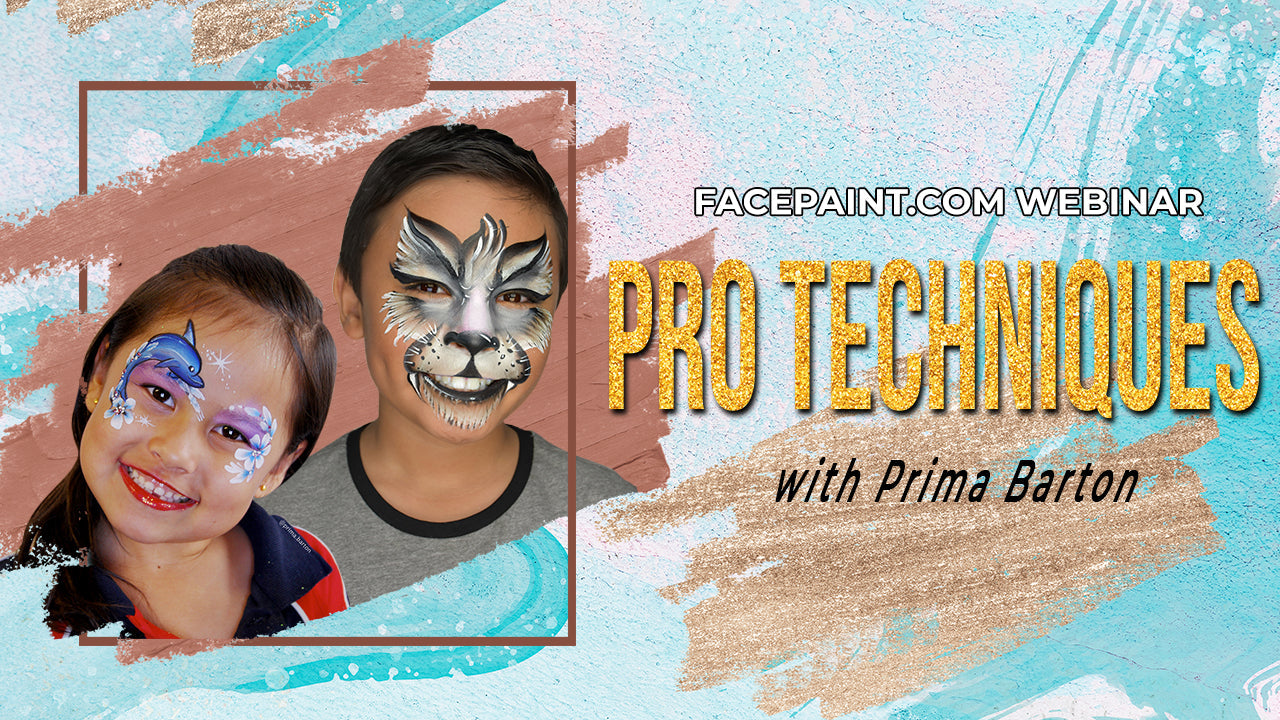
An interesting conversation came up on one of the face painting Facebook groups this last week. It began, "How do I decide what to charge for face painting?" This is one of the most asked questions for not only new face painters, but also face painters who have been painting for awhile.
In this conversation, the group offered lots of helpful suggestions which ranged from researching the general rate in the area (which is a good place to start and will help you avoid doing a lot of math on your own) to shooting from the hip and choosing a rate based on what you feel would be "enough." I will admit that when I started face painting, I chose a rate out of a hat without doing any research, and it was a terrible mistake on my part.
As I thought it over, I realized that guesswork is not necessary when it comes to creating your face painting rate. Being an artist doesn't mean that you're any less a businessperson, and you should crunch some real numbers before making that final decision of what to charge. If you've forgotten some of those great algebra word problems you slogged through as a kid, I hope this post will provide a workable formula for figuring out what you need to know.
If you've been running a business for awhile and have an electronic spreadsheet, hopefully it will give you the following information and make this whole process a lot easer: gross income, expenses, and travel mileage. If you're brand new, you're going to have to rely on the information you can glean from other artists about how much it costs to run a business and how much of a time investment it will be for you. If you're new to the business, I guarantee two things. It will cost far more than you will expect, and it will take far more time that you anticipate.
STEP ONE: How many hours do you work each week?
The first step is to know how much time you put into your face painting business each week. (My guess is that it's more than you think.) Track your time for a couple of weeks and make sure you don't miss any of the following.
• Responding to phone calls, texts, and emails
• Responding to inquiries and quote requests
• Creating contracts and invoices
• Creating spreadsheets, forms, and other paperwork items
• Keeping all records in order for tax preparation
• Following up with clients to make sure contracts and invoices are returned in a timely manner
• Event preparation (making menus for themed events)
• Practicing and training (workshops, classes, conventions, and personal practice)
• Advertising
• Creating/updating/servicing your website and online galleries and profiles
• Social media promotion
• Creating new designs
• Cleaning and organizing after each event (kit, brushes, sponges, chair, etc.)
• Purchasing/re-ordering supplies
• Researching equipment and supplies
• Traveling to events
• Face painting
STEP TWO: What are your total expenses?
Now that you're equipped with the knowledge of how much time you're investing in your business each week, ask yourself how much you spend on your business in expenses. (Hopefully you've been keeping excellent records of every expenditure, including your mileage, because you'll need that information to do this.) If you are just starting out, you can figure that for the first year, you would be spending at least 50% of $100 per hour on your business.
STEP THREE: What is your hourly wage? (And what would you like it to be?)
Remember that this is not the hourly rate you charge clients. This is your hourly wage. If you're putting in a 40 hour work week running the business, what do you actually net per hour after expenses and taxes?
For example, let's pretend that you have discovered you work a 40 hour week. You'd probably like to walk away with at least $400 for your trouble, because that would be approximately $10 per hour. It's not necessarily a livable wage, but at least it's not lower than minimum wage, which is where a lot of face painters may find themselves at the end of this process.
Now for the math. How do you work backwards to find out what you have to make in a week to end up with that $400? I'm going to base this on some average numbers, but you can substitute your own to make it work for you. I'm going to use 30% for self-employment taxes and 40% for expenses, although some years my expenses have been higher than that, depending on my base rate.
Question 1: How much do I have to make before taxes to make $400 per week as my net income? (Or, 70% of what number will equal $400?)
We're asking this because the $400 is the 70% that's left after you remove the 30% which is your taxes. (No, you can't take 30% from $400. That would be incorrect.)
0.70 x N = $400
N = $400 / 0.70
N = $571.43
So before you actually remove the taxes, you have to have made at least $571.43 (or about $572) in order to achieve your $400 paycheck. But wait! There's more! We have to deal with those pesky expenses, too, and they come out before taxes, so we have to create a formula for that as well.
Question 2: What gross income before expenses must I have to make $400 for my weekly net income? (Or, 60% of what number will equal $572?)
0.60 x N = $572
N = $572 / 0.60
N = $953.33
Now if I've done my math right, I've been able to work backwards and find out that for each week, I need to take in about $954 total in order to get a $400 paycheck for the week and pay myself at least $10 per hour if I'm changing $100 per hour.
This means if I'm face painting 10 hours a week and working a 40 hour work week including office time, etc, I have to charge at least $100 per hour to make $10 per hour as an hourly wage. Because there are weeks that I may paint fewer hours but still put in a full work week, especially in the winter months when there are fewer large parties but still doing plenty of office work, like tax preparation, revamping my visual menus, and preparing special jewel accessories for the summer, my hourly rate is $125 to $150 to cover those hours or they would become unpaid hours.
What about face painters who only want to charge $50 per hour? Well, it's pretty bad for them, and the reason is that a higher percentage of their gross goes to expenses. They will have to be incredibly careful with not only their expenditures, but also with their time management to make anything close to minimum wage. Let's see how it works out with the math.
Things will be the same when it comes to taxes. 70% of what number will equal $400. So far, nothing has changed.
0.70 x N = $400
N = $400 / 0.70
N = $571.43
It's the next step that really hits the artists charging a lower wage. You can cut some corners. You can go without a website and just use Facebook and Instagram and other social media to get customers, but those are time-eaters if you're not careful. A website also increases your internet visibility and professional image, bringing more customers. In short, people are more likely to hire you if you have a professional looking website. So it's not just a cost. It's a business investment. You can go without insurance, but you won't get those corporate events (and quite a few others), because they require it. At some point, however, the pennies you pinch will restrict your business growth.
So what if your expenses are 90% instead of 40% of your gross income? That's likely to be the case if you have very low rate, like $50 per hour. (My first year my expenses were almost 100%, but we'll just pretend that we're not actually investing that 10% back in the business.)
0.10 x N = $572
N = $572 / 0.10
N = $5720.00
Yeah, that's right. You have to gross $5720 to make at least $400 per week if you're charging $50 per hour and if your expenses are 90% of what you're taking in. That means you have to work 114.4 hours per week to make $400 per week. Now, realistically it wouldn't come out quite like that, because some of your costs wouldn't increase with the number of hours you work. I'd have to do a breakdown of my expenses and separate the ones which are yearly costs from those which increase as my painting time increases (like travel and supplies). For example, the cost of your insurance and website are yearly costs that are set and don't get larger no matter how many hours you work. But your travel expenses increase because you incur them per event. Your product costs increase because you incur them per event. And your office time usage will definitely increase because you'll be fielding quotes and doing contracts constantly, meaning your more likely to put in a 60 hour week or more, which will make your hourly wage decrease.
What if you're able to keep your expenses down to at least 50% of your gross? What happens to our numbers then? I don't think it's realistic, but it's possible.
0.50 x N = $572
N = $572 / 0.50
N = $1144.00
For face painters out there charging $50 per hour, they'll have to face paint 23 hours every week to make $10 per hour. The big if is whether or not they can keep that expense margin down at 50%, which isn't likely if they're only charging $50 per hour.
You should have noticed one disturbing factor almost right off the bat, even if you aren't any good at math. The $400 net income is WAY less than the $954 gross income you started out with. The vast majority of what you make goes right back into the business and to taxes. If you're charging too low an hourly rate, it's not coming out of your taxes or expenses. Those are set amounts that you're going to have regardless of what you charge your client. Therefore, any bad pricing on your part will mean you get an hourly wage that's ridiculously low and certainly not livable.
Face painters who are charging $50 an hour are probably only netting a dollar or two per hour as a wage (if that), and that's only if they are extremely careful with their time usage and expenses.
So do face painters make an exorbitant amount as face painters? No, they don't. I always smile when I'm working and an adult in line explains to her friends how she's going to go into business herself and make a haul face painting. Most face painters do what they do primarily because they love making children happy by face painting them rather than because they're making lots of money. But at the end of the day, face painters are still running real businesses with real taxes and real bills like everyone else. If they want their businesses to survive, they have to take the bottom line into account and do a realistic business evaluation. If a face painter is only making one or two dollars an hour (or less) as an hourly wage, he or she will need to make changes for her business to be able to continue in the future.
_____
Beth MacKinney is the owner of and primary face painter for Face Paint Pizzazz in Elgin, Illinois, and her artwork has appeared in The Colored Palette and SkinMarkz magazines. She services the western and northwestern Chicago suburbs, Chicago’s north side, and the eastern and southeastern suburbs of Rockford. Stop by Clownantics.com to enjoy more of Beth’s face painting tutorials.
 FREE SHIPPING FOR USA ORDERS OVER $100
FREE SHIPPING FOR USA ORDERS OVER $100








Leave a comment (all fields required)